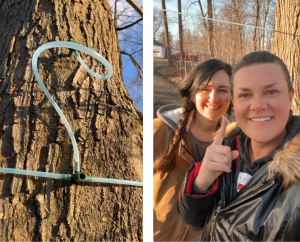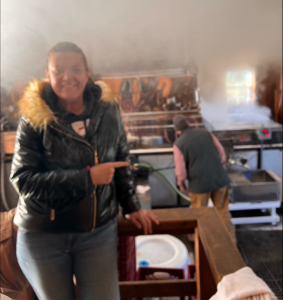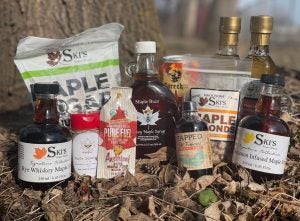Spring is a time to collect sap from maple trees but all year round it’s a sweet treat! There are many products beyond maple syrup to enjoy such as maple cream, maple popcorn, and maple sugar.
A maple syrup producer in Plymouth, Wisconsin, has their products labeled as “happiness is homemade.” For most producers across the nation, it’s a family business and it’s rewarding for producers to come together during spring and sell products throughout the year. Homemade is especially important for the industry as pure maple syrup is simple maple tree sap that’s boiled to a thicker consistency and nothing else is added.
The process of maple syrup begins with finding and tapping a maple tree. Drilling a hole into the tree will allow sap to flow into a container to eventually be processed to maple syrup. After the season, the hole is healed and the tree itself can last over 100 years if maintained well. Then, once the weather is right, sap will flow. Sap will flow best when the temperature during the day is above freezing and is below freezing in the evening. Some producers will use a pipeline for maple syrup to flow into while for other producers, it’s a family tradition to collect the bag or buckets.
Here I’m doing it with my friend Kristin at Patterson Fruit Farm in Ohio:

After collecting the sap, it must be boiled. Depending on the sugar content of the sap, generally it takes 40 gallons of sap to make 1 gallon of maple syrup. Because syrup is a natural sweetener, there are no added sugar, preservatives, or other additives. It takes a lot of time and effort for the maple syrup to make it to the store shelf.
Here, Kristin took me to her “boiler room.” It’s foggy and steamy!

Producers across the nation are innovatively thinking of ways to incorporate maple syrup into everyday products. Maple syrup can be used in many ways, like as a caramelization for a meat like pork or chicken. This helps to flavor the meat and helps the skin caramelize. Some other ways to incorporate maple syrup into many products already consumed, including popcorn, scones, pie, cocktails, roasted vegetables, fajitas, soup, bread pudding.
Other products that include maple syrup are maple seasoning, Sprecher’s Maple Root Beer, maple suckers, maple taffy, honey maple vinaigrette, maple almonds, and maple coffee. Some of these products include only a few more ingredients to create the maple-value added product.

Alternative syrups have more ingredients found on the label including corn syrup and artificial maple extract. It may be found cheaper than maple syrup since it’s less labor-intensive than maple syrup production with tapping, collecting, and boiling.
Ultimately, maple syrup can be a healthier alternative compared to an artificial sweetener. Maple syrup has 24 antioxidants that can help protect consumers from health conditions and strengthen the immune system.
The industry nationwide in 2022 produced over 5 million gallons of maple syrup. State leaders include Vermont, followed by New York, Maine, and Wisconsin. Year after the year, the community continues to grow, but for many, it’s a family business from generation to generation.
Michelle Miller, the Farm Babe, is a farmer, public speaker and writer who has worked for years with row crops, beef cattle, and sheep. She believes education is key in bridging the gap between farmers and consumers.


